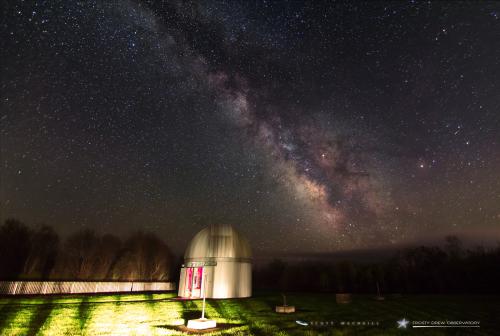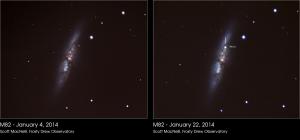Celebration of Space - May 26, 2023

The Milky Way over Frosty Drew Observatory and Ninigret Park with a little light from distant headlights. Credit: Frosty Drew Astronomy Team member, Scott MacNeill
Tomorrow night, Saturday, May 27, 2023, starting at 8:30 pm, the first collaboration of Frosty Drew Observatory and Science Center with the Charlestown RI Dark Sky Advocates will happen, in a jointly hosted star party event. The theme of the event is the celebration of the world at night. Everything from the fabulous night sky to the animals and birds that come to life at night. At Frosty Drew, our astronomers take for granted all the amazing life we experience out in the dark. The owls that swoop at us, the coyotes that howl and chat the night away, the constant whoop of the eastern whip-poor-wills, and so much more. It is a world that so much of humanity has forgotten about, and are sadly missing out on. Charlestown Rhode Island still has this amazing natural resource, and the experience is beautiful.
The star party event is also about bringing out your own telescopes, binoculars, and stargazing equipment to observe. It will give attendees a chance to geek out with their gear, show off their rigs, and learn about what other enthusiasts are doing. It’s also a fantastic opportunity for those without their own equipment to come out and enjoy the cosmos through many different types of telescopes, and to make connections with the astronomy enthusiast community. The weather is looking fantastic for tomorrow night, and it should be an amazing event. Tickets are NOT required to attend this event, and the Frosty Drew Observatory will be open to host views through our 24 inch PlaneWave telescope. So swing by for an amazing nighttime experience and get acquainted with other astro geeks in the region. Visit the Charlestown RI Dark Sky Advocates to learn more about the event.
Over the past two weeks, a new star-like object has appeared in Messier 101 – The Pinwheel Galaxy (M101). When observing galaxies outside of the Milky Way, it is very uncommon to see changes, as galactic life cycles are so long compared to the life of your average homo sapiens. Though uncommon, we do occasionally see such events happen. Nearly every time this happens, it is the result of a supernova that occurred in that galaxy, but what type of supernova is an entirely different question, and the answer is important in regards to our understanding of the event, and the galaxy that it occurred in. In case of M101, the bright object is a supernova, and has been cataloged as SN 2023ifx. When studying a supernova in another galaxy, we are often looking for a Type 1a Supernova, which is when a white dwarf star, that is a component of a binary star system, explodes due to the accumulation of matter on its surface, that has been stolen from the other star in the system. Type 1a supernovae always happen at 1.44 solar masses, which is known as the Chandrasekhar Mass. Because of this, these types of supernovae are always the same brightness, and allow us to calculate a higher precision in distance to the galaxy that hosted the supernova. But SN 2023ifx is not a Type 1a, it is actually a Type IIb supernova.
Type IIb supernovae are the result of high mass stars that die. Similar to the death of most stars, a high mass star will go the extra mile. Meaning that, in the Milky Way Galaxy, 97% of stars will collapse until they reach the Chandrasekhar Limit (1.4 solar masses), at which time all electrons in the star will push off really hard, due to their increasingly close proximity to each other, and expose the core of the star to space. That dead core is known as a white dwarf. Though the other 3% of stars have over 9 solar masses, and will exceed the Chandrasekhar Limit when all electrons can’t get any closer. The result is that the electrons do not succeed in repelling gravitational collapse when they have their big push. So all the electrons in the star combine with their protons and form neutrons, allowing collapse to continue. But once all the neutrons in the star end up in close proximity, they will push off catastrophically hard, and explosively blast the outer layers of the star off, exposing the dead, neutron heavy core. That event is called a Type IIb Supernova, and leaves behind a neutron star, and sometimes a black hole.
At Frosty Drew, our 24 inch telescope is strong enough to visually observe SN 2023ifx, and we will attempt to capture images of it this weekend. We may even try for a visual observation at the end of tonight’s session (May 25, 2023). Regardless, the supernova will be visible for a few more weeks before it becomes too dim to see. Here is a recent Astronomy Picture of the Day post of SN 2023ifx.
Evening passes of the International Space Station (ISS) will continue through the holiday weekend, and into next week, ending on Thursday, June 1, 2023. Though because of our proximity to the Summer Solstice, evening passes of the ISS, including all night long passes, will kick back in on July 10, 2023. There are some spectacular passes happening over the weekend, and with clear sky conditions on the docket, this is the time to catch a view! Here are several notable passes for this weekend:
Fri, May 26 at 9:37 pm, starting in the NW, rising to 32º, heading towards the E, and into orbital sunset
Fri, May 26 at 11:03 pm, starting in the WNW, rising to 23º, and into orbital sunset
Sat, May 27 at 8:38 pm, starting in the NW, rising to 24º heading towards the ENE
Sat, May 27 at 10:14 pm, starting in the WNW, rising to 64º, and into orbital sunset ← Awesome pass!
Sun, May 28 at 9:26 pm, starting in the NW, rising to 74º, heading towards the ESE, and into orbital sunset ← Awesome pass!
Mon, May 29 at 8:37 pm, starting in the NW, rising to 44º, heading towards the ESE
Mon, May 29 at 10:14 pm, starting in the W, rising to 22º, and into orbital sunset
Tue, May 30 at 9:25 pm, starting in the WNW, rising to 29º, heading towards the SSE, and into orbital sunset
Put these times on your calendar and set your alarms. Viewing the ISS pass overhead is a fantastic experience that can really inspire confidence and ambition in the minds of the younger generation, and it gets you out looking at the sky! For daily pass times of the ISS over the Northeast, visit the Frosty Drew Daily Satellite Pass Prediction Utility. Now get out there and be inspired!
- Author:
- Scott MacNeill
- Entry Date:
- May 26, 2023
- Published Under:
- Scott MacNeill's Columns



